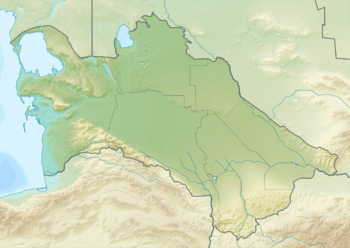1948 Ashgabat earthquake
 Serdar Darreh Gaz | |
| Date | 5 October 1948 |
|---|---|
| Magnitude | 7.3 Ms |
| Epicenter | 37°57′N 58°19′E / 37.95°N 58.32°ECoordinates: 37°57′N 58°19′E / 37.95°N 58.32°E |
| Areas affected |
Soviet Union (Turkmen SSR) Iran |
| Max. intensity | X (Extreme)[1] |
| Casualties | 10,000–110,000[2] |
The 1948 Ashgabat earthquake (Turkmen: 1948 Ашгабат ыер титремеси; 1948 Aşgabat yer titremesi; Russian: Ашхабадское землетрясение 1948 года; Ashkhabadskoye zemletryasenie 1948 goda) occurred on 6 October with a surface wave magnitude of 7.3 and a maximum Mercalli intensity of X (Extreme). The shock occurred in Turkmenistan near Ashgabat. Due to censorship by the Turkmen government, the event was not widely reported in the USSR's media. Historians tend to agree that the ban on reporting the extent of the casualties and damage did not allow the Soviet government to allocate enough financial resources to adequately respond.[3]
Details
The earthquake struck at 2:17 in the morning on 6 October 1948. The epicenter of the earthquake was located near the small village of Gara-Gaudan, 25 kilometers southwest of Ashgabat. The earthquake caused extreme damage in Ashgabat and nearby villages, where almost all brick buildings collapsed, concrete structures were heavily damaged, and freight trains were derailed. Damage and casualties occurred in Darreh Gaz, Iran. Surface rupture was observed northwest and southeast of Ashgabat. Media sources vary on the number of the casualties, from 10,000 to 110,000, equivalent to almost 10% of the Turkmen SSR's population at the time.
According to memoirs of survivors, the city's infrastructure was badly damaged, with the exception of water pipes. Electricity was restored six days after the earthquake. The railway station began functioning on the third day.
This earthquake killed future Turkmen president Saparmurat Niyazov's mother Gurbansoltan Eje (his father having died during World War II) and the rest of his family, leaving him an orphan.[4] Aid to victims, as well as restoration of basic needs and infrastructure, was provided by the Soviet Army.

See also
References
- ↑ "Comments for the significant earthquake". Significant Earthquake Database. National Geophysical Data Center. Retrieved 12 June 2015.
- ↑ USGS (September 4, 2009), PAGER-CAT Earthquake Catalog, Version 2008_06.1, United States Geological Survey
- ↑ http://www.scgis.ru/russian/cp1251/h_dgggms/ca_2-1998.htm#1 Russian Academy of Sciences. Department of Geology, Geophysics, Geochemistry and Mining Sciences. Electronic Scientific Information Journal "HERALD OF THE DGGGMS RAS" № 2(4)'1998. Last retrieved: 17 Jan. 2010
- ↑ Cummings, Sally N. Power and Change in Central Asia, p.118. Routledge (2002), ISBN 0-415-25585-6.